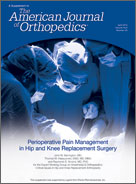Perioperative Pain Management in Hip and Knee Replacement Surgery
John W. Barrington, MD; Thomas M. Halaszynski, DMD, MD, MBA; Raymond S. Sinatra, MD, PhD; for the Expert Working Group on Anesthesia & Orthopaedics: Critical Issues in Hip and Knee Replacement Arthroplasty
Many patients who undergo hip or knee replacement surgery today experience high levels of postoperative pain. Data from clinical studies and analyses of hospital records have demonstrated that severe postoperative pain is associated with an increased risk for complications, slowing of the rehabilitation process, delayed return to normal functioning, progression to persistent pain states, prolonged length of hospital stay, elevated rates of readmission, and higher overall costs. Orthopedic surgeons may now play a more active role in reducing the severity of pain following surgery, decreasing both opioid use and the incidence of opioid-related adverse events, and eliminating breakthrough pain and analgesic gaps. The benefits of multimodal regimens that include a combination of agents acting synergistically have been established unequivocally, and many analgesic and anesthetic agents are now available, as well as treatment options that differ according to route of administration. It is therefore possible to individualize treatment based on the type of procedure and patient need. One exciting advance that offers effective, safe, and efficient analgesia for many kinds of surgical procedures is the introduction of an extended-release local anesthetic (liposomal bupivacaine) for infiltration. This new option, which can be administered directly
into the knee or hip by an orthopedic surgeon, is an example of the changing paradigm in perioperative analgesia, where commitment, communication, and coordination across all members of the clinical care team—including the surgeon, anesthesiologist, pharmacist, physical therapist, and nursing staff—are fundamental elements of an improved standard of care. An Expert Working Group on Anesthesia & Orthopaedics: Critical Issues in Hip and Knee Replacement Arthroplasty (April 13, 2013; Dallas, Texas) evaluated current approaches to perioperative pain management and proposed new regimens to help achieve optimal outcomes in these procedures.

